Characterization of Ecosystem Services and Their Trade-Off and Synergistic Relationships under Different Land-Use Scenarios on the Loess Plateau
Abstract
:1. Introduction
2. Materials and Methods
2.1. Study Area
2.2. Data Sources
2.3. Methods
2.3.1. Land-Use Prediction Based on the PLUS Model
2.3.2. Ecosystem Service Assessment
- (1)
- Water yield
- (2)
- Carbon storage
- (3)
- Soil conservation
2.3.3. Ecosystem Service Trade-Off and Synergy Analysis
3. Results
3.1. Land-Use Change and Scenarios Simulation
3.2. Changes in Ecosystem Services
3.3. The Analysis of the Trade-Offs and Synergies of ESs
4. Discussion
4.1. Land-Use Impacts on Ecological Services
4.2. Research Limitations and Future Research Directions
5. Conclusions
Author Contributions
Funding
Data Availability Statement
Conflicts of Interest
References
- Costanza, R.; d’Arge, R.; Groot, R.d.; Farber, S.; Grasso, M.; Hannon, B.; Limburg, K.; Naeem, S.; O’Neill, R.V.; Paruelo, J.; et al. The value of the world’s ecosystem services and natural capital. Ecol. Econ. 1998, 25, 253–260. [Google Scholar] [CrossRef]
- Fu, B.J.; Zhou, G.Y.; Bai, Y.F.; Yong, C.C.; Liu, J.Y.; Zhang, H.Y.; Lv, Y.H.; Zheng, H.; Xie, G.D. The Main Terrestrial Ecosystem Service and Ecological Security in China. Adv. Earth Sci. 2009, 24, 571–576. [Google Scholar]
- Parkes, M. Personal Commentaries on “Ecosystems and Human Well-being: Health Synthesis—A Report of the Millennium Ecosystem Assessment”. EcoHealth 2006, 3, 136–140. [Google Scholar] [CrossRef]
- Martínez-López, J.; Bagstad, K.J.; Balbi, S.; Magrach, A.; Voigt, B.; Athanasiadis, I.; Pascual, M.; Willcock, S.; Villa, F. Towards globally customizable ecosystem service models. Sci. Total Environ. 2019, 650, 2325–2336. [Google Scholar] [CrossRef] [PubMed]
- Zhang, Z.C.; Zhang, H.J.; Feng, J.; Wang, Y.Y.; Liu, K. Evaluation of Social Values for Ecosystem Services in Urban Riverfront Space Based on the SolVES Model: A Case Study of the Fenghe River, Xi’an, China. Int. J. Environ. Res. Public Health 2021, 18, 2765. [Google Scholar] [CrossRef]
- Wang, Y.; Meng, J.J.; Qi, Y.; Peng, F.L. Review of Ecosystem Management Based on the InVEST Model. Chin. J. Ecol. 2015, 34, 3526–3532. [Google Scholar] [CrossRef]
- Wang, X.F.; Zhang, X.R.; Feng, X.M.; Liu, S.R.; Yin, L.C.; Chen, Y.Z. Trade-offs and Synergies of Ecosystem Services in Karst Area of China Driven by Grain-for-Green Program. Chin. Geogr. Sci. 2020, 30, 101–114. [Google Scholar] [CrossRef]
- Groff, S.C.; Loftin, C.S.; Drummond, F.; Bushmann, S.; McGill, B. Parameterization of the InVEST Crop Pollination Model to spatially predict abundance of wild blueberry (Vaccinium angustifolium Aiton) native bee pollinators in Maine, USA. Environ. Model. Softw. 2016, 79, 1–9. [Google Scholar] [CrossRef]
- Li, Y.; Li, S.C.; Gao, Y.; Wang, Y. Ecosystem services and hierarchic human well-being: Concepts and service classification framework. Acta Geogr. Sin. 2013, 68, 1038–1047. [Google Scholar]
- Bennett, E.M.; Peterson, G.D.; Gordon, L.J. Understanding relationships among multiple ecosystem services. Ecol. Lett. 2009, 12, 1394–1404. [Google Scholar] [CrossRef]
- Shi, M.J.; Wu, H.Q.; Fan, X.; Jia, H.T.; Dong, T.; He, P.X.; Fahad, B.M.; Jiang, P.G. Trade-Offs and Synergies of Multiple Ecosystem Services for Different Land Use Scenarios in the Yili River Valley, China. Sustainability 2021, 13, 1577. [Google Scholar] [CrossRef]
- Sylla, M.; Hagemann, N.; Szewrański, S. Mapping trade-offs and synergies among peri-urban ecosystem services to address spatial policy. Environ. Sci. Policy 2020, 112, 79–90. [Google Scholar] [CrossRef]
- Wang, X.C.; Dong, X.B.; Liu, H.M.; Liu, H.M.; Wei, H.J.; Fan, W.G.; Lu, N.C.; Xu, Z.H.; Ren, J.H.; Xing, K.X. Linking land use change, ecosystem services and human well-being: A case study of the Manas River Basin of Xinjiang, China. Ecosyst. Serv. 2017, 27, 113–123. [Google Scholar] [CrossRef]
- Rimal, B.; Sharma, R.; Kunwar, R.; Keshtkar, H.; Stork, N.E.; Rijal, S.; Rahman, S.A.; Baral, H. Effects of land use and land cover change on ecosystem services in the Koshi River Basin, Eastern Nepal. Ecosyst. Serv. 2019, 38, 100963. [Google Scholar] [CrossRef]
- Huang, L.; Zhu, P.; Cao, W. The Impact of the Grain for Green Projec on the Trade-off and Synergy Relationships among Multiple Ecosystem Services in China. Acta Ecol. Sin. 2021, 41, 1178–1188. [Google Scholar]
- Anchal, J.; Upender, S.; Rakesh, S.; Swapna, S.; Anil, K. Impact of change of land use on ecosystem services. Curr. Adv. Agric. Sci. 2020, 12, 113–116. [Google Scholar]
- Xie, L.; Wang, H.W.; Liu, S.H. The ecosystem service values simulation and driving force analysis based on land use/land cover: A case study in inland rivers in arid areas of the Aksu River Basin, China. Ecol. Indic. 2022, 138, 108828. [Google Scholar] [CrossRef]
- Sunsanee, A.; Shrestha, R.P. Assessing Land Use Change and Its Impact on cosystem Services in Northern Thailand. Sustainability 2016, 8, 768. [Google Scholar]
- Hasan, S.S.; Lin, Z.; Miah, M.G.; Ahamed, T.; Samie, A. Impact of land use change on ecosystem services: A review. Environ. Dev. 2020, 34, 100527. [Google Scholar] [CrossRef]
- Cao, Q.W.; Gu, C.L.; Guan, W.H. China’s urbanization SD modelling and simulation based on land use. J. Nat. Resour. 2021, 36, 1062–1084. [Google Scholar] [CrossRef]
- Shao, Z.L.; Chen, C.Y.; Liu, Y.L.; Cao, J.; Liao, G.T.; Lin, Z.Y. Impact of Land Use Change on Carbon Storage Based on FLUS-InVEST Model: A Case Study of Chengdu–Chongqing Urban Agglomeration, China. Land 2023, 12, 1531. [Google Scholar] [CrossRef]
- Xu, Q.L.; Wang, Q.; Liu, J.; Liang, H. Simulation of Land-Use Changes Using the Partitioned ANN-CA Model and Considering the Influence of Land-Use Change Frequency. ISPRS Int. J. Geo-Inf. 2021, 10, 346. [Google Scholar] [CrossRef]
- Guan, D.J.; Zhao, Z.L.; Tan, J. Dynamic simulation of land use change based on logistic-CA-Markov and WLC-CA-Markov models: A case study in three gorges reservoir area of Chongqing, China. Environ. Sci. Pollut. Res. Int. 2019, 26, 20669–20688. [Google Scholar] [CrossRef] [PubMed]
- Lin, X.F.; Fu, H. Spatial-Temporal Evolution and Driving Forces of Cultivated Land Based on the PLUS Model: A Case Study of Haikou City, 1980–2020. Sustainability 2022, 14, 14284. [Google Scholar] [CrossRef]
- Zhao, M.M.; He, Z.B.; Du, J.; Chen, L.F.; Lin, P.F.; Fang, S. Assessing the effects of ecological engineering on carbon storage by linking the CA-Markov and InVEST models. Ecol. Indic. 2019, 98, 29–38. [Google Scholar] [CrossRef]
- Zheng, H.W.; Shen, G.Q.; Wang, H.; Hong, J.K. Simulating land use change in urban renewal areas: A case study in Hong Kong. Habitat Int. 2015, 46, 23–34. [Google Scholar] [CrossRef]
- Hu, Y.N.; Peng, J.; Liu, Y.X.; Tian, L. Integrating ecosystem services trade-offs with paddy land-to-dry land decisions: A scenario approach in Erhai Lake Basin, southwest China. Sci. Total Environ. 2018, 625, 849–860. [Google Scholar] [CrossRef]
- Peng, J.; Hu, X.Y.; Wang, X.Y.; Meersmans, J.; Liu, Y.X.; Qiu, S.J. Simulating the impact of Grain-for-Green Programme on ecosystem services trade-offs in Northwestern Yunnan, China. Ecosyst. Serv. 2019, 39, 100998. [Google Scholar] [CrossRef]
- Shoemaker, D.A.; BenDor, T.K.; Meentemeyer, R.K. Anticipating trade-offs between urban patterns and ecosystem service production: Scenario analyses of sprawl alternatives for a rapidly urbanizing region. Comput. Environ. Urban Syst. 2019, 74, 114–125. [Google Scholar] [CrossRef]
- Min, G.; Yan, X.; Hu, Y.F. Evaluation of Water Yield and Soil Erosion in the Three-River-Source Region under Different Land-Climate Scenarios. J. Resour. Ecol. 2020, 11, 13–26. [Google Scholar] [CrossRef]
- Lin, S.W.; Wu, R.D.; Yang, F.L.; Wang, J.J.; Wu, W. Spatial trade-offs and synergies among ecosystem services within a global biodiversity hotspot. Ecol. Indic. 2018, 84, 371–381. [Google Scholar] [CrossRef]
- Fan, Y.T.; Jin, X.B.; Gan, L.; Lin, J.H.; Yang, Q.K.; Lv, L.G.; Li, Y. Spatial characteristics and influencing mechanism of trade-offs between multiple land use functions in the Yangtze River Delta region. Resour. Sci. 2022, 44, 1589–1603. [Google Scholar] [CrossRef]
- Chawanji, S.; Masocha, M.; Dube, T. Spatial assessment of ecosystem service trade-offs and synergies in Zimbabwe. Trans. R. Soc. South Afr. 2018, 73, 172–179. [Google Scholar] [CrossRef]
- Zhao, X.Y.; Ma, P.Y.; Li, W.Q.; Du, Y.X. Spatiotemporal Changes of the Supply and Demand of Ecosystem Services in the Loess Plateau. Acta Geogr. Sin. 2021, 76, 2780–2796. [Google Scholar]
- Zhang, L.X.; Fan, J.W.; Zhao, H.Y.; Zhou, D.C. Spatio-temporal Variations and Their Driving Forces of Ecological Vulnerability in the Loess Plateau. Environ. Sci. 2022, 43, 4902–4910. [Google Scholar]
- Wei, L.; Fu, B.J.; Wang, C.; Zhang, W.B.; Zhao, J.; Feng, X.M.; Yan, J.W.; Liu, Y.; Zhou, S. Quantification of the ecosystem carrying capacity on China’s Loess Plateau. Ecol. Indic. 2019, 101, 192–202. [Google Scholar]
- Fu, B.J.; Wang, S.; Liu, Y.; Liang, W.; Miao, C.Y. Hydrogeomorphic Ecosystem Responses to Natural and Anthropogenic Changes in the Loess Plateau of China. Annu. Rev. Earth Planet. Sci. 2017, 45, 223–243. [Google Scholar] [CrossRef]
- Liang, X.; Guan, Q.; Clarke, K.C.; Liu, S.S.; Wang, B.Y.; Yao, Y. Understanding the drivers of sustainable land expansion using a patch-generating land use simulation (PLUS) model: A case study in Wuhan, China. Comput. Environ. Urban Syst. 2021, 85, 101569. [Google Scholar] [CrossRef]
- Chen, M.; Vernon, C.R.; Graham, N.T.; Hejazi, M.; Huang, M.Y.; Cheng, Y.Y.; Calvin, K. Global land use for 2015–2100 at 0.05° resolution under diverse socioeconomic and climate scenarios. Sci. Data 2020, 7, 320. [Google Scholar] [CrossRef]
- Donohue, R.J.; Roderick, M.L.; McVicar, T.R. Roots, storms and soil pores: Incorporating key ecohydrological processes into Budyko’s hydrological model. J. Hydrol. 2012, 436–437, 35–50. [Google Scholar] [CrossRef]
- Zhang, L.; Dawes, W.R.; Walker, G.R. Response of mean annual evapotranspiration to vegetation changes at catchment scale. Water Resour. Res. 2001, 37, 701–708. [Google Scholar] [CrossRef]
- Yang, J.; Xie, B.P.; Zhang, D.G. Spatio-temporal variation of water yield and its response to precipitation and land use change in the Yellow River Basin based on InVEST model. J. Appl. Ecol. 2020, 31, 2731–2739. [Google Scholar]
- Xu, L.; He, N.P.; Yu, G.R. A dataset of carbon density in Chinese terrestrial ecosystem (2010s). China Sci. Data 2019, 4, 90–96. [Google Scholar]
- Yang, J.; Xie, B.P.; Zhang, D.G. Spatio-temporal evolution of carbon stocks in the Yellow River Basin based on InVEST and CA-Markov models. Chin. J. Eco-Agric. 2021, 29, 1018–1029. [Google Scholar]
- Li, M.Y.; Shangguan, Z.P.; Deng, L. Spatial distribution of carbon storage in the terrestrial ecosystem and its influencing factors on the Loess Plateau. Acta Ecol. Sin. 2021, 41, 6786–6799. [Google Scholar]
- Yu, H.; Jin, L.; Tang, B.X.; Qi, Z.; Shen, M.T.; Mou, S.H. Trade-off and Synergy Analysis of Ecological Services of Grain for Green Program in Loess Plateau: A Case Study of Ansai County. Chin. J. Ecol. 2023, 42, 544–551. [Google Scholar]
- Renard, K.G.; Foster, G.R.; Weesies, G.A.; Porter, J.P. Rusle: Revised universal soil loss equation. Soil Water Conserv. 1991, 46, 30–33. [Google Scholar]
- Zhang, W.B.; Fu, J.S. Rainfall erosivity estimation under different rainfall amount. Resour. Sci. 2003, 1, 35–41. [Google Scholar]
- Williams, J.R. The Erosion-Productivity Impact Calculator (EPIC) Model: A Case History. Philos. Trans. Biol. Sci. 1990, 329, 421–428. [Google Scholar]
- Harmáčková, Z.V.; Vačkář, D. Modelling regulating ecosystem services trade-offs across landscape scenarios in Třeboňsko Wetlands Biosphere Reserve, Czech Republic. Ecol. Model. 2015, 295, 207–215. [Google Scholar] [CrossRef]
- Lv, Y.; Fu, B.; Feng, X.; Zeng, Y.; Liu, Y.; Chang, R.; Sun, G.; Wu, B. A policy-driven large scale ecological restoration: Quantifying ecosystem services changes in the Loess Plateau of China. PLoS ONE 2017, 7, e31782. [Google Scholar]
- Bradford, J.B.; D’Amato, A.W. Recognizing trade-offs in multi-objective land management. Front. Ecol. Environ. 2012, 10, 210–216. [Google Scholar] [CrossRef] [PubMed]
- Wang, B.S.; Liao, J.F.; Zhu, W.; Qiu, Q.Y.; Wang, L.; Tang, L.N. The weight of neighborhood setting of FLUS model based on a historical scenario: A case study of land use simulation of urban agglomeration of the Golden Triangle of Southern Fujian in 2030. Acta Ecol. Sin. 2019, 39, 4284–4298. [Google Scholar]
- Babbar, D.; Areendran, G.; Sahana, M.; Sarma, K.; Raj, K.; Sivadas, A. Assessment and prediction of Carbon Sequestration using Markov chain and InVEST model in Sariska Tiger Reserve, India. J. Clean. Prod. 2021, 278, 123333. [Google Scholar] [CrossRef]
- Chaudhuri, G.; Clarke, K.C. Modeling an Indian megalopolis–A case study on adapting SLEUTH urban growth model. Comput. Environ. Urban Syst. 2019, 77, 101358. [Google Scholar] [CrossRef]
- Gong, J.Z.; Hu, Z.R.; Chen, W.R.; Liu, Y.S.; Wang, J.Y. Urban expansion dynamics and modes in metropolitan Guangzhou, China. Land Use Policy 2018, 72, 100–109. [Google Scholar] [CrossRef]
- Ning, J.; Shao, Q.Q. Temporal and spatial characteristics of land use and ecosystem services in the Loess Plateau. J. Agro-Environ. Sci. 2020, 39, 774–785. [Google Scholar]
- Wang, X.Z.; Wu, J.Z.; Wu, P.X.; Shangguan, Z.P.; Deng, L. Spatial and Temporal Distribution and Trade-offs of Water Conservation, Soil Conservation and NPP Services in Ecosystem of the Loess Plateau from 2000 to 2015. J. Soil Water Conserv. 2021, 35, 114–121+128. [Google Scholar]
- Yang, J.; Xie, B.P.; Zhang, D.G. Spatial-temporal heterogeneity of ecosystem service trade-off synergy in the Yellow River Basin. J. Desert Res. 2021, 41, 78–87. [Google Scholar]
- Lyu, R.F.; Zhang, J.M.; Xu, M.Q.; Li, J.J. Impacts of urbanization on ecosystem services and their temporal relations: A case study in Northern Ningxia, Chinac. Land Use Policy 2018, 77, 163–173. [Google Scholar] [CrossRef]
- Lang, Y.Q.; Song, W.; Zhang, Y. Responses of the water-yield ecosystem service to climate and land use change in Sancha River Basin, China. Phys. Chem. Earth 2017, 101, 102–111. [Google Scholar] [CrossRef]
- Hou, G.R.; Bi, H.X.; Wei, X.; Zhou, Q.Z.; Kong, L.X.; Wang, J.S.; Jia, J.B. Water Conservation Function of Litter sand Soil in Three Kinds of Woodlands in Gully Region of Loess Platea. J. Soil Water Conserv. 2018, 32, 357–363+371. [Google Scholar]
- Feng, Q.; Zhao, W.W.; Hu, X.P.; Liu, Y.; Daryanto, S.; Cherubini, F. Trading-off ecosystem services for better ecological restoration: A case study in the Loess Plateau of China. J. Clean. Prod. 2020, 257, 120469. [Google Scholar] [CrossRef]
- Li, T.; Lv, Y.H.; Fu, B.J.; Hu, W.Y.; Comber, A.J. Bundling ecosystem services for detecting their interactions driven by large-scale vegetation restoration: Enhanced services while depressed synergies. Ecol. Indic. 2019, 99, 332–342. [Google Scholar] [CrossRef]
- Liu, K.D.; Yang, D.G.; Wang, G.H.; Zhou, Z.T. Policy Modeling and Simulationon Ecological Civilization Constructionin China Based on System Dynamics. Chin. J. Manag. Sci. 2020, 28, 209–220. [Google Scholar]
- Liu, Z.X.; Ruan, Y.L. The Research on the Comprehensive Evaluation and Spatiotemporal Evolution of Ecological Tax and Environmental Integration Development in China. Ecol. Econ. 2022, 38, 179–187. [Google Scholar]
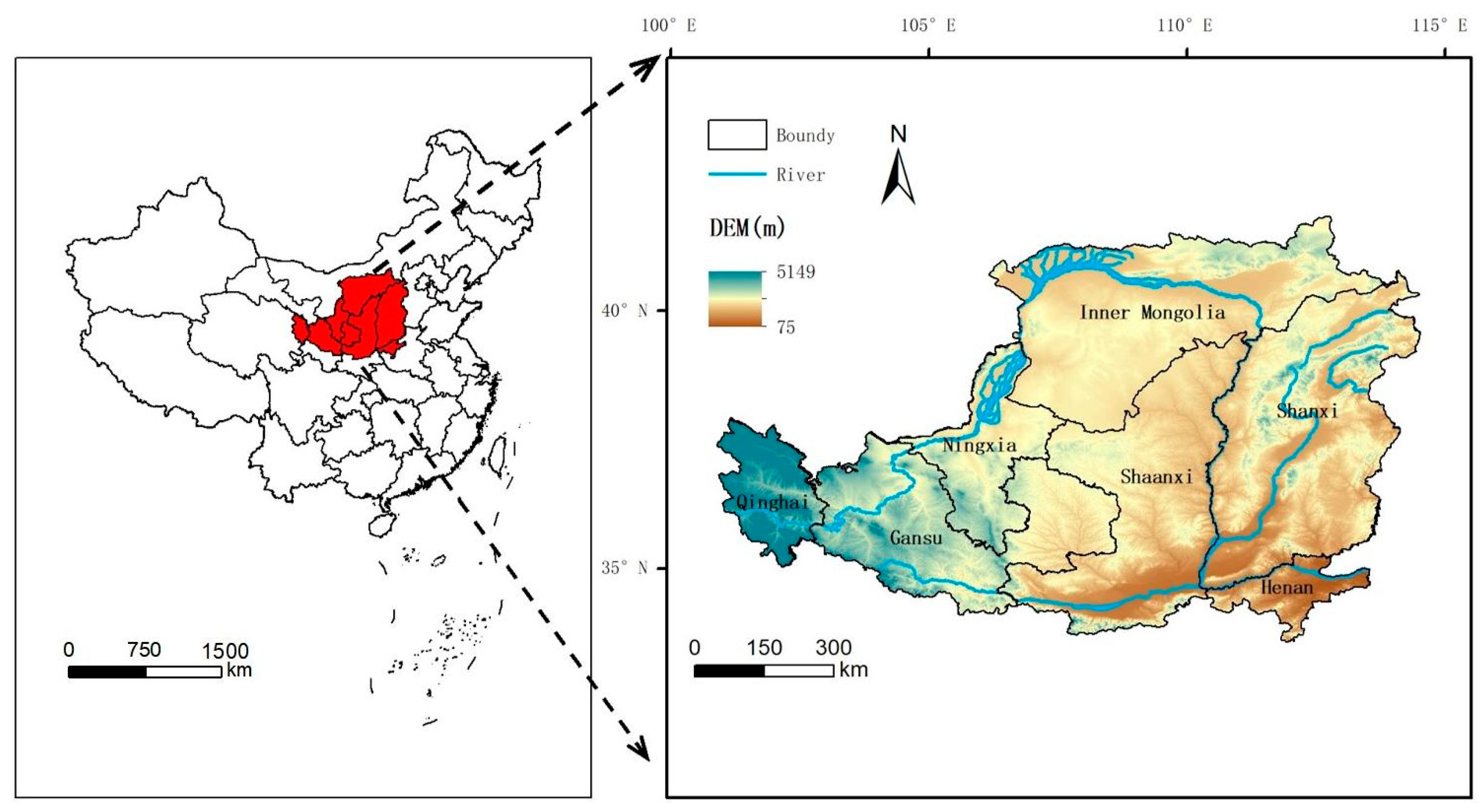
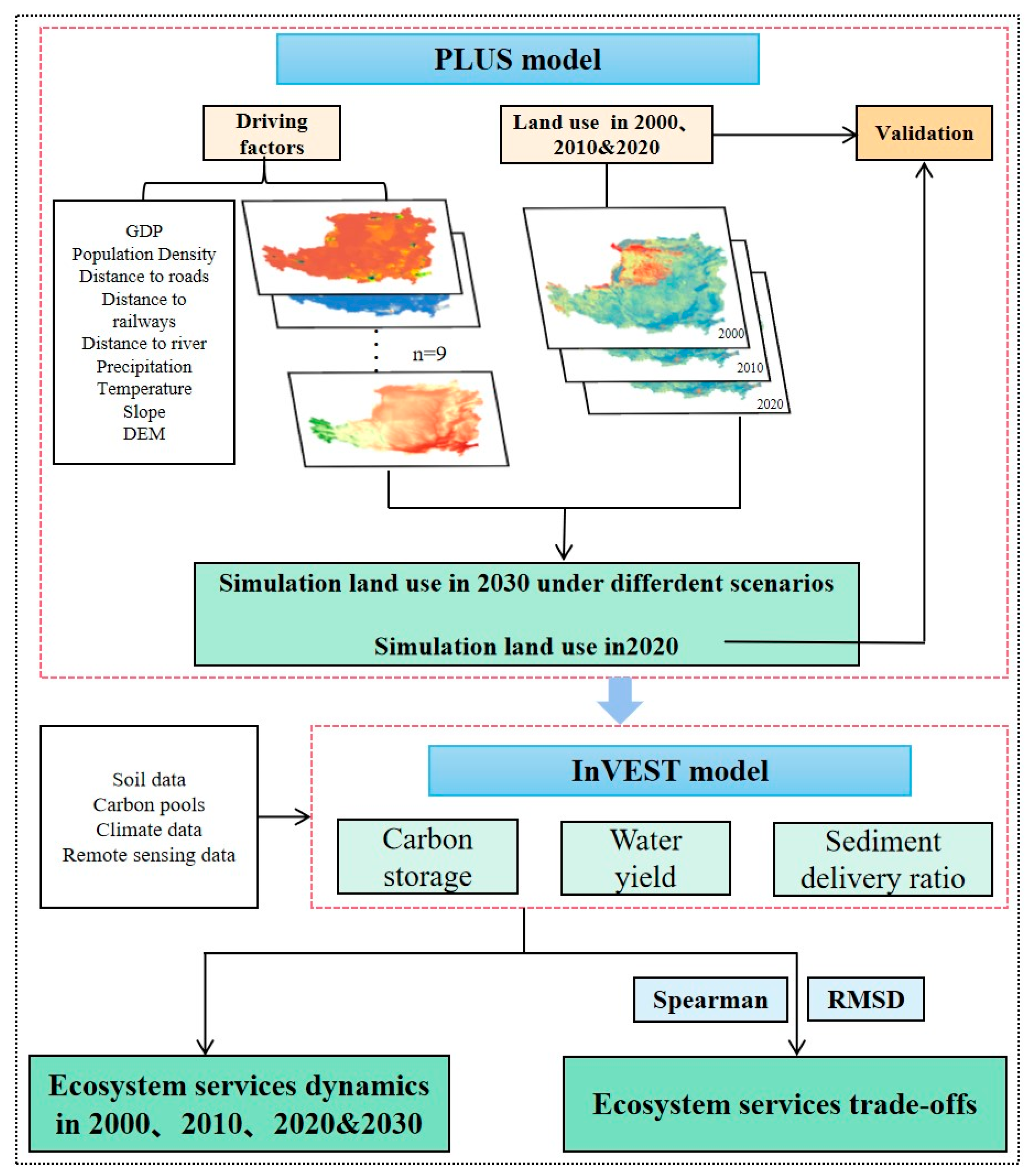

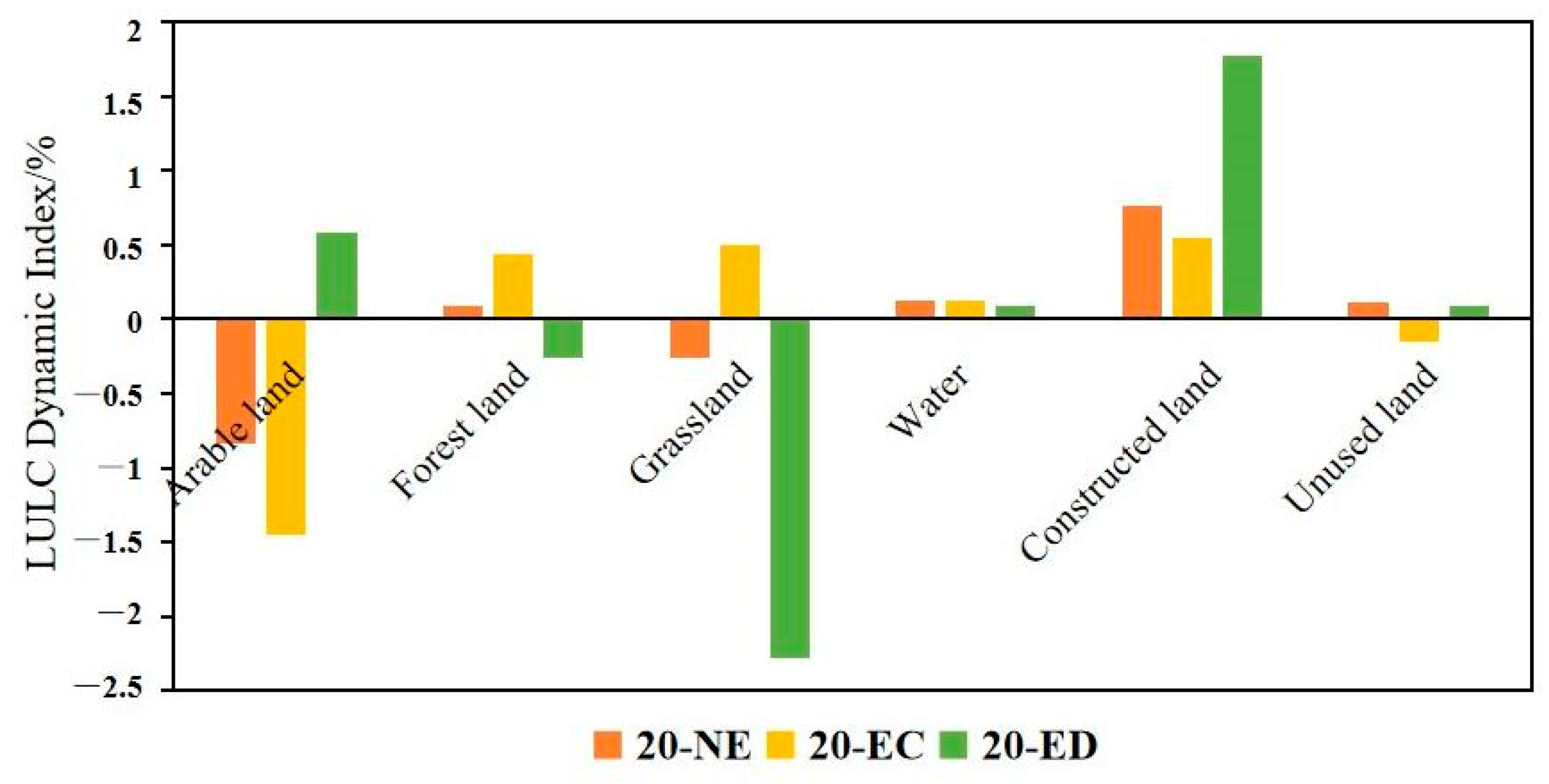
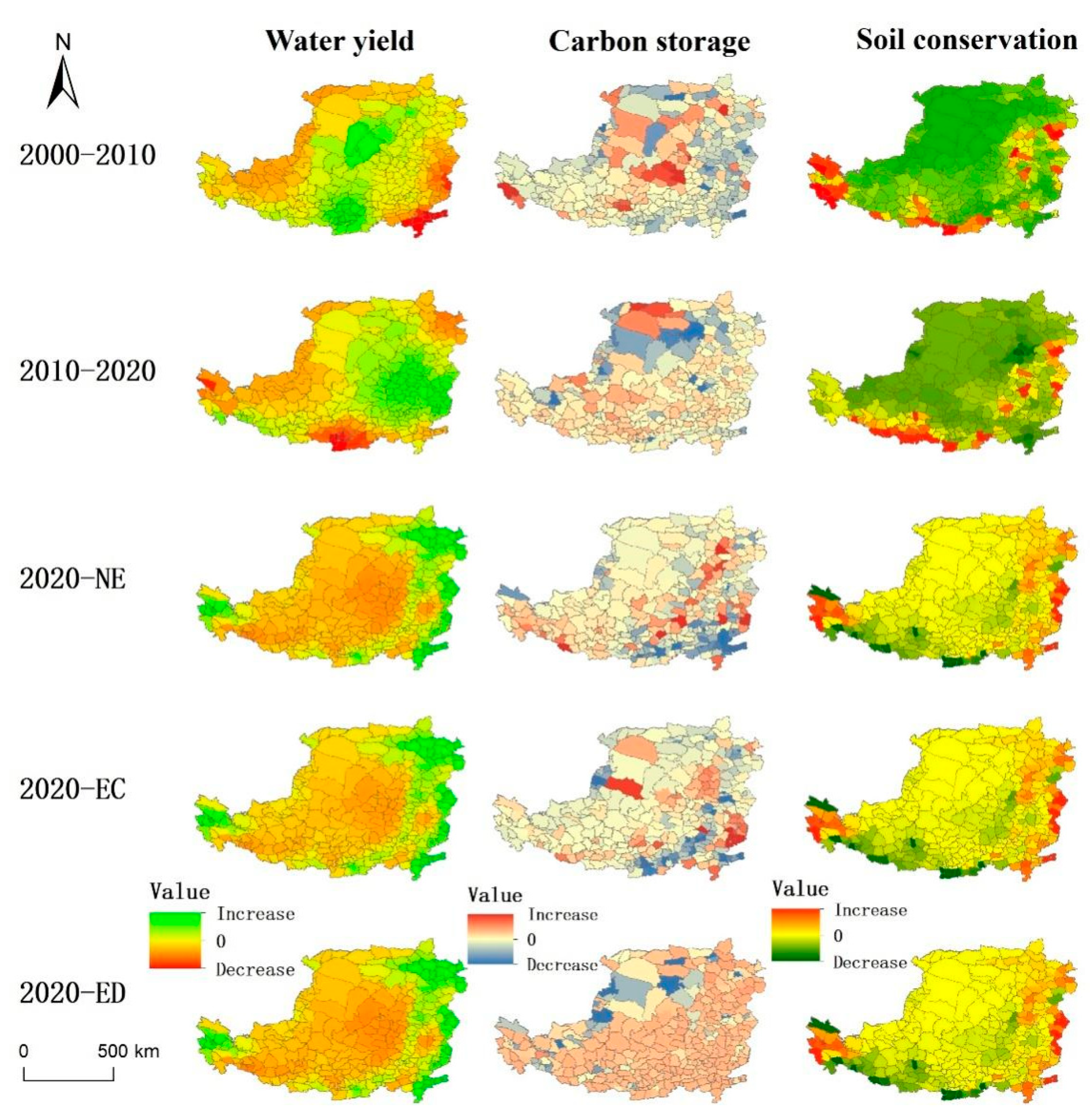
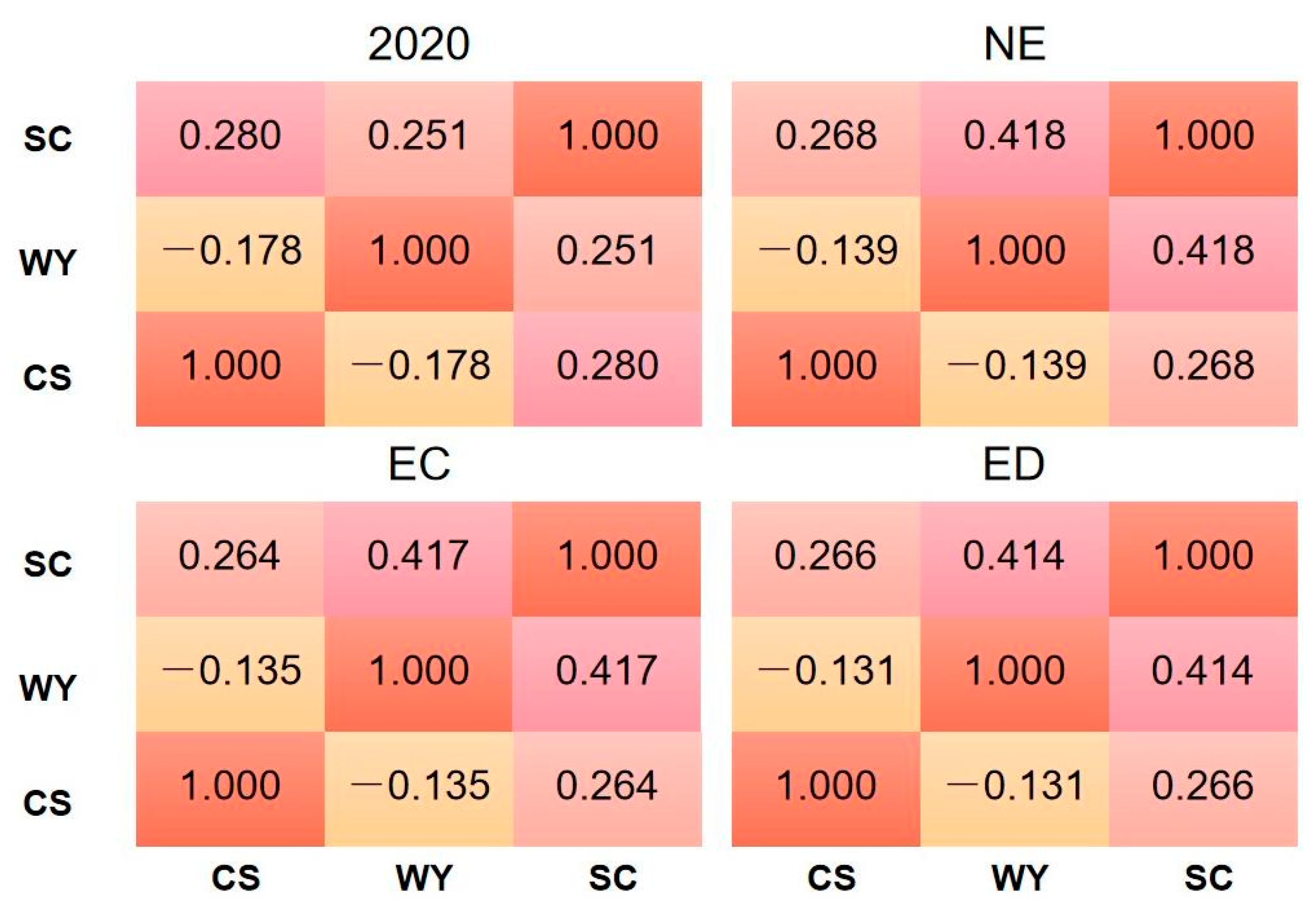

| Water Yield | Carbon Storage | Soil Conservation | ||||
|---|---|---|---|---|---|---|
| Average (mm) | Total (108 m3) | Average (t/km2) | Total (108 t) | Average (t/km2) | Total (108 t) | |
| 2000 | 47.46 | 315.27 | 5724.289 | 37.278 | 3930.694 | 30.39 |
| 2010 | 74.044 | 488.718 | 5738.746 | 37.371 | 5098.921 | 38.99 |
| 2020 | 102.44 | 672.825 | 5709.73 | 37.18 | 5760.772 | 44.32 |
| NE | 169.52 | 1116.4 | 5683.91 | 37.012 | 5615.22 | 43.19 |
| EC | 169.15 | 1114.08 | 5732.82 | 37.33 | 5622.94 | 43.247 |
| ED | 170.09 | 1120.06 | 5587.04 | 36.38 | 5567.32 | 42.9 |
Disclaimer/Publisher’s Note: The statements, opinions and data contained in all publications are solely those of the individual author(s) and contributor(s) and not of MDPI and/or the editor(s). MDPI and/or the editor(s) disclaim responsibility for any injury to people or property resulting from any ideas, methods, instructions or products referred to in the content. |
© 2023 by the authors. Licensee MDPI, Basel, Switzerland. This article is an open access article distributed under the terms and conditions of the Creative Commons Attribution (CC BY) license (https://creativecommons.org/licenses/by/4.0/).
Share and Cite
Xiong, M.; Li, F.; Liu, X.; Liu, J.; Luo, X.; Xing, L.; Wang, R.; Li, H.; Guo, F. Characterization of Ecosystem Services and Their Trade-Off and Synergistic Relationships under Different Land-Use Scenarios on the Loess Plateau. Land 2023, 12, 2087. https://doi.org/10.3390/land12122087
Xiong M, Li F, Liu X, Liu J, Luo X, Xing L, Wang R, Li H, Guo F. Characterization of Ecosystem Services and Their Trade-Off and Synergistic Relationships under Different Land-Use Scenarios on the Loess Plateau. Land. 2023; 12(12):2087. https://doi.org/10.3390/land12122087
Chicago/Turabian StyleXiong, Maoqiu, Fujie Li, Xiaohuang Liu, Jiufen Liu, Xinping Luo, Liyuan Xing, Ran Wang, Hongyu Li, and Fuyin Guo. 2023. "Characterization of Ecosystem Services and Their Trade-Off and Synergistic Relationships under Different Land-Use Scenarios on the Loess Plateau" Land 12, no. 12: 2087. https://doi.org/10.3390/land12122087
APA StyleXiong, M., Li, F., Liu, X., Liu, J., Luo, X., Xing, L., Wang, R., Li, H., & Guo, F. (2023). Characterization of Ecosystem Services and Their Trade-Off and Synergistic Relationships under Different Land-Use Scenarios on the Loess Plateau. Land, 12(12), 2087. https://doi.org/10.3390/land12122087





